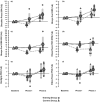Cross-education attenuates muscle weakness and facilitates strength recovery after orthopedic immobilization in females: A pilot study
- PMID: 40285446
- PMCID: PMC12032444
- DOI: 10.14814/phy2.70329
Cross-education attenuates muscle weakness and facilitates strength recovery after orthopedic immobilization in females: A pilot study
Abstract
This pilot study consists of a two-phase intervention to examine the effectiveness of unilateral resistance training to mitigate the negative consequences of immobilization and expedite the restoration of muscle strength and size following a period of retraining. Ten females were randomized to a unilateral training (TRAIN, n = 6) or control (CON, n = 4) group. During Phase 1, all participants wore an arm sling for a total of 4 weeks on their non-dominant arm. This phase required the TRAIN group to perform unilateral resistance training with the non-immobilized arm while the CON group did not. Phase 2 commenced thereafter and consisted of 4 weeks of bilateral resistance training for both groups. Outcome measures of neuromuscular function and muscle size were assessed at baseline and after each phase, with neuromuscular function quantified by maximal dynamic and isometric strength alongside electromyographic responses and muscle size measured using ultrasonography and regional lean mass via DEXA. Unilateral training of the non-immobilized arm during Phase 1 attenuated dynamic (p < 0.05; g > 1.2), but not isometric (p > 0.40; g < 0.095), strength loss following immobilization and showed large effects for improving the recovery of strength after retraining. Similarly, the imaging data show the relative changes in muscle size and regional lean mass of the non-dominant arm favor TRAIN. Although the small sample prevents definitive conclusions, our study suggests resistance training of the non-immobilized arm attenuates muscle weakness and atrophy for the contralateral, immobilized arm during immobilization and facilitates their recovery following retraining.
Keywords: early medical intervention; physical therapy; resistance training; sports medicine.
© 2025 The Author(s). Physiological Reports published by Wiley Periodicals LLC on behalf of The Physiological Society and the American Physiological Society.
Conflict of interest statement
The authors declare no conflicts of interest.
Figures



Similar articles
-
Strength training the free limb attenuates strength loss during unilateral immobilization.J Appl Physiol (1985). 2009 Mar;106(3):830-6. doi: 10.1152/japplphysiol.91331.2008. Epub 2009 Jan 15. J Appl Physiol (1985). 2009. PMID: 19150859
-
Corticospinal adaptations and strength maintenance in the immobilized arm following 3 weeks unilateral strength training.Scand J Med Sci Sports. 2013 Dec;23(6):740-8. doi: 10.1111/j.1600-0838.2012.01453.x. Epub 2012 Mar 19. Scand J Med Sci Sports. 2013. PMID: 22429184
-
Effects of cross-education on the muscle after a period of unilateral limb immobilization using a shoulder sling and swathe.J Appl Physiol (1985). 2010 Dec;109(6):1887-94. doi: 10.1152/japplphysiol.00597.2010. Epub 2010 Oct 21. J Appl Physiol (1985). 2010. PMID: 20966196
-
Contralateral effects of unilateral training: sparing of muscle strength and size after immobilization.Appl Physiol Nutr Metab. 2018 Nov;43(11):1131-1139. doi: 10.1139/apnm-2018-0073. Epub 2018 Mar 9. Appl Physiol Nutr Metab. 2018. PMID: 29800529 Review.
-
Cross education and immobilisation: mechanisms and implications for injury rehabilitation.J Sci Med Sport. 2012 Mar;15(2):94-101. doi: 10.1016/j.jsams.2011.07.007. Epub 2011 Sep 15. J Sci Med Sport. 2012. PMID: 21924681 Review.
References
-
- Andrushko, J. W. , Carr, J. C. , Farthing, J. P. , Lepley, L. K. , DeFreitas, J. M. , Goodall, S. , Hendy, A. M. , Howatson, G. , Grooms, D. R. , Zult, T. , Hortobagyi, T. , Harput, G. , Papandreou, M. , Nosaka, K. , Carson, R. G. , Manca, A. , Deriu, F. , Behm, D. G. , Kidgell, D. J. , … Boyd, L. A. (2023). Potential role of cross‐education in early‐stage rehabilitation after anterior cruciate ligament reconstruction. British Journal of Sports Medicine, 57, 1474–1475. - PubMed
-
- Andrushko, J. W. , Lanovaz, J. L. , Björkman, K. M. , Kontulainen, S. A. , & Farthing, J. P. (2017). Unilateral strength training leads to muscle‐specific sparing effects during opposite homologous limb immobilization. Journal of Applied Physiology, 124, 866–876. 10.1152/japplphysiol.00971.2017 - DOI - PMC - PubMed
Publication types
MeSH terms
Grants and funding
LinkOut - more resources
Full Text Sources

